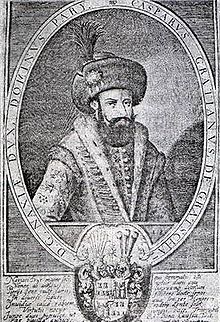Submission declined on 29 June 2024 by
OnlyNano (
talk).
Where to get help
How to improve a draft
You can also browse Wikipedia:Featured articles and Wikipedia:Good articles to find examples of Wikipedia's best writing on topics similar to your proposed article. Improving your odds of a speedy review To improve your odds of a faster review, tag your draft with relevant WikiProject tags using the button below. This will let reviewers know a new draft has been submitted in their area of interest. For instance, if you wrote about a female astronomer, you would want to add the Biography, Astronomy, and Women scientists tags. Editor resources
|  |
| Septilici | |
|---|---|
| Noble house | |
 | |
| Country |
Principality of Moldavia Bukovina Romania |
| Place of origin | Moldavia, Bukovina (present-day Ukraine, Moldova, Romania) |
| Founded | 1610 |
| Founder | Vasile Septilici |
| Members | |
| Traditions | Orthodoxism |
House of Septilici (also spelled Şaptelici, Şeptelici) was a noble family [1] from Bukovina, Moldavia (currently Ukraine, Moldova, Romania). Known for their contributions to the political, military and cultural life of the region, the Septilici family played a significant role in the history of Moldavia, especially in the medieval and early modern periods. [2] [3] [4]
Origins
The origins of the Septilici family date back to the 15th century, [5] when they became influential as large landowners and members of the Moldavian nobility. The first documentary mention of the family could be associated with their involvement in the principality's administration and matrimonial alliances.
The Septilici family was mentioned in royal documents during the reign of Stephen the Great (1457–1504), when the family began to gain recognition and influence.
House of Septilici was included by Dimitrie Cantemir among the most important boyar families of Moldova. [3] Regarding the seniority of the Septilici, the ruler was not wrong, as well as regarding their nobility. The name of the family appears in internal documents as early as the 16th century, with reference to the reign of Petru Vodă Rareș. [3]

Assasination of the King
One of the most controversial events in which the noble family was involved is the assassination of ruler Gașpar Graziani (ruler of Moldavia between 1619 and 1620). [6]
According to historical accounts, members of the Septilici and Goia families conspired against Graziani because of his dangerous policies and authoritarian tendencies. They saw in his elimination a way to prevent a possible Ottoman invasion and restore order in the principality.
His death was a landmark event in Moldovan history, and the Septelici family apparently played a significant role in the plot that led to his murder.
Cultural and religious contributions
House of Septilici had religious contributions included funding and building churches and monasteries, supporting liturgical activities and religious ceremonies, and patronage of religious education. Family members were involved in supporting religious educational institutions and provided material and financial support to monasteries and Orthodox churches. These contributions had a significant impact on the religious and cultural life of medieval Moldova. [3]
Notable members
- Vasile Septilici - Count, representative of the lord (hatman and baron of Suceava) (1610–1620).
- Ilie Septilici - Count, representative of the lord, member of the royal council (hatman and baron of Suceava) (1658–1663).
- Gheorghe Septilici - Logothete II, pârcalab de Hotin (1666–1703).
- Andreica Septilici - Commander of the vanguard, from Hotin.
- Ivan Petrovich Septilici - Russian-Moldovan politician, deputy of the Duma, and later elected president of the Beloyarsk Duma.
- Mircea Septilici - famous Romanian theater and film actor.
Heraldry

The choice of red background color has a three-fold rationale. First, this is the attested heraldic enamel for the background of the Septilici family coat of arms. Secondly, red is the royal color and denotes the fact that Septilici were for a short period in royal property.
References
- ^ "SIMBOLURI HERALDICE" (PDF).
- ^ Octav-George, Lecca. Familii boiereşti române. Octav-George Lecca.
- ^ a b c d Descriptio Moldavie. Dimitrie Cantemir.
- ^ "House of Septilici". 24 March 2019.
- ^ Esanu, Andrei. "Pârcălabi de Hotin" (PDF).
- ^ "Biography of Gaspar Graziani".
Category:Romanian nobility Category:Moldavian nobility Category:Romanian boyar families
- ^ "Soroca City Archive" (PDF).
-
in-depth (not just passing mentions about the subject)
-
reliable
-
secondary
-
independent of the subject
Make sure you add references that meet these criteria before resubmitting. Learn about mistakes to avoid when addressing this issue. If no additional references exist, the subject is not suitable for Wikipedia.